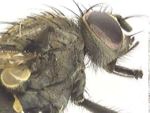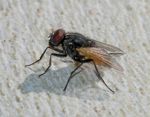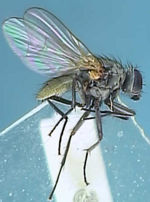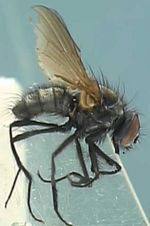Nuisance Flies
Jump to navigation
Jump to search
| This article has been peer reviewed but is awaiting expert review. If you would like to help with this, please see more information about expert reviewing. |
|
|
Introduction
The family Muscidae contains many non-biting (nuisance) flies and blood sucking (biting) flies. There are only two nuisance flies of veterinary importance, these are the Musca spp. and Hydrotaea.
Nuisance flies are not only irritating to animals, but can also carry serious diseases and so should be controlled from an animal welfare point of view.
Hydrotaea irritans
- Also known as the 'head fly'
- Hydrotaea irritans the main species of veterinary importance
- Mainly a problem of sheep
- In some areas it is the most numerous fly of cattle and horses
Recognition
- Similar to Musca spp.
- Olive green abdomen
- 4-7mm in length
Life Cycle
- Eggs laid in decaying vegetation, faeces and in carrion (in the summer months)
- Emerging larvae overwinter (diapause) and pupate in spring
- Adult flies emerge in the summer
- One generation per year
Pathogenesis
- Cattle
- Evidence suggests that they transmit summer mastitis
- Sheep
- Cause extreme irritation
- Mouthparts rasp the skin to feed on secretions and exudate
- Leads to self-inflicted damage
- E.g. 'Broken Head'
- Secondary bacterial infection may occur
- Blowfly strike may follow
- Cause extreme irritation



